-

人教版新目标初中英语七年级下册I want to be an actor教案2篇
三、教学建议第一课时:1. Lead in (Vocabulary)A) Before class, teacher should collect some pictures of working places. For example: Bank, TV Station, Restaurant, Police Station, Hospital ...B) In class, show students the pictures (PowerPoint, OHP). Ask students to tell the name of the working places and the name of the jobs.Shop assistant, doctor, actor, reporter, police office, waiter, bank clerk, studentC) Do exercise 1a and 3a.2. Bingo GameAsk groups of students to make up pairs of cards with a job on one and the related workplace on the other. For example, waiter / restaurant, teacher / school, doctor / hospital. Encourage students to use both the job / workplace combinations in the book and the ones that students came up during class discussions. Be sure they have twice as many sets of cards as there are students in the group. They can make two sets of cards for a single job / workplace, if necessary. Then have each group mix up its set of cards and hand their cards out in random order. Each time a student gets a pair of cards that match, he or she can lay these cards down. The goal is to have no cards in your hand at the end.3. Task OneA) Ask students to work in pairs and ask the partner what does he / she want to be in the future.e. g. :What do you / does he / does she want to be?I want to be a.Why?Because it's (adj).B) Vocabulary: Section B, 1a4. Homework 1.2.

人教版新目标初中英语七年级下册Why do you like koalas教案2篇
单元整体说明(一)单元教材分析本单元的核心话题是描述动物和表达个人喜好,以及句式why do you like…? Because…。这也是本单元的教学重点。通过本单元的学习,学生应能较流利地运用所学词汇和句型描述动物,表达个人喜好。(二)单元知识结构1.词汇动物名称 tiger, elephant, koala, dolphin, etc.词汇描述性形容词: smart, cute, ugly, clever, shy, etc.国家名: Australia, South Africa2.句型Why do you like koala hears? Because they are cute.Where are pandas from? They're from China.What animals do you like? I like dolphins.(三)单元整体目标1.Master the vocabulary2.Master and use: Why do you like koalas? Because they am cute.Where are pandas from? They're from China.What animals do you like? I like dolphins.(四)单元教学重难点一览(五)单元学情分析学生此前已经学过由why, where, what 引导的特殊疑问句句型,具有了学习本单元知识的认知前提。形形色色的动物能激发学生的好奇心,产生了解它们的欲望,这有利于本单元知识的教学和学生学习兴趣的培养。

人教版新目标初中英语八年级上册How do you get to school教案2篇
Step Ⅶ Role play ( Work on 1b)1. First ask two students to read the dialogue to the class.Sa: How do you get to school?Sb: Well, I ride my bike to the subway station. Then I take the subway.2. Now work with a partner.Suppose you use two kinds of transportation to get to school \Hangzhou\Beijing... (bus, train, subway, walking, bike, etc.) Tell how you get there. You may use the phrases in 1a.3. Then ask different pairs of students to present their conversations to the class.Step ⅧListening1. Work on 2a(1) First ask students to read the list of information that Thomas wants to know.…where Nina lives.…how far from school she lives.…how long it takes to get to school.…how she gets to school.…what she thinks of the transportation.(2) Tell students what transportation and bus stop mean.bus stop 汽车站 transportation n. 运送;运输Then tell students we'll hear a recording. Please put a checkmark in front of each thing that Thomas wants to know.(3) Now play the recording for students.( Have students pay attention to the sample answer.) (4) Then correct the answers.

人教版新目标初中英语八年级上册What are you doing for vacation教案2篇
Teaching goals : 1. Words & phrases: babysit ,get back , fishing , rent , think about , decide(on) , tourist etc. 2. How to talk about future plans . 3. 现在进行时表示将来计划或行动. 4. 特殊疑问句(where , when , how long引导) Important and difficult points : Drills :What are you doing for vacation ? I’m watching TV . When are you going ? I’m going … . How long are you staying ? We’re staying for five days . Teaching aids : cards and a tape ,a large wall calendar . Period 1 Teaching procedures : Step 1Leading in1. Free talk . 2. Put up the wall calendar . T: I’m staying home on Saturday (pointing to next Saturday ).Ss repeat . Ss: I’m staying home on Saturday . T: OK. Today we’ll learn how to talk about future plans. Step 2Pre-task SB Page 13 , 1a . 1. Look at the picture carefully and tell what you see in the picture . 2. Write the activities from the pictures in the box and add some more . 3. Practice reading . Step 3While-task1. Using the activities we write in 1a to make conversations .For example :What are you doing for vacation ? I’m visiting my uncle . 2. Pairwork .Practice in pairs . 3. 用第三人称练习对话.

人教版新目标初中英语八年级上册What’s the matter教案2篇
She shouldn’t go to the party tonight.Step7. TaskT: You know, there are lots of problems in our life. If you are a doctor, please tell us how to solve the problem. I will divide you into 9 groups. Please work in groups. And then choose one of you to report your ideas.The following are the problems:I have a toothache.I am hungry. I have a sore throat.I am stressed out. I have a sore back.I am tired. I can’t sleep.I have a cold. I have a headache.Report: If you have a headache, you should go to bed early. You should see the doctor. You should eat some medicine. You shouldn’t wash your face with cold water.You shouldn’t sleep late.You shouldn’t swim.…..T encourages the students to give advice as much as possible.Homework:1. Chose one of the problems, and write down your advice2. Copy the new words这一步是用于热身的,同时也可以让他们复习一部分的表示人体部位的单词,扩充知识.学习语言的过程也是一个不断积累的过程,复习旧知识,增添新知识.通过小游戏,强化学生对Does she/he have…这个句子的运用能力.通过复习,自然的引到下面新知识的学习。充分利用表格,由句子到对话,再到文章,让学生循序渐进. 提高学生的综合语言运用能力,运用以前学过的知识来解决身边的问题.Period 5 (Section B 3a—3c, selfcheck)教学内容与分析:

人教版新目标初中英语八年级下册If you go to the party, you’ll have a great time教案2篇
区分宾语从句、定于从句和状语从句宾语从句和状语从句,都叫做主从复合句。宾语从句主要是中考必考的,是初中阶段必掌握的从句,宾语从句主要是掌握三要素,所谓宾语从句,就是宾语在主从复合句当中充当宾语的一个句子,叫做宾语从句。主句的谓语动词是及物动词,后面如果是词或者是短语的话,是简单句,如果是句子的话,肯定是宾语从句。I know that he good at English.就是宾语从句,三要素,一要素是要注意连词,连词一共学了三类连词,一类连词是that口语当中可以省略,就像刚才说的那一句,I hear he is good at English.还有疑问代词、疑问副词,how where when,疑问代词、疑问副词。还有一类连词weather是否的意思,不是状语从句当中的如果,这一定要和如果区分开,这是是否。I don't know if he interested at English。宾语从句要注意if是连词。第二要素是语序,要用陈述举语序。比如说你家有几口人,我们都说How many people are there in you family?但是这是简单句,一旦说成宾语从句,你可以告诉我你家有几口人吗?Could you tell me how many people there are in you family ?

人教版新目标初中英语九年级上册How do you study for a test教案2篇
内容提示本单元主要内容是学会利用verb十by/with gerund表示方式方法来讨论学习英语的策略,认识自己在学习方面的长处和不足。初步了解现在完成时的结构和用法。现在完成时由助动词have/has+动词的过去分词构成,主要表示过去发生的某一动作对现在仍有影响或造成的后果,常与already,yet,just,ever,never等副词连用。教学目标一、学习目标(Language Goal) 1. Talk about how to study . 学会讨论各种学习方法和策略。2. Find out your suitable learning methods. 找出适合自己的学习方法。 二、语言结构(Language Structures) 1. Verb + by with gerund by+动名词短语 表示“通过…途径,方法” 2. How questions have引导的特殊疑问句 三、目标语言(Target Language) 1. How do you study for tests ? 你是怎样准备考试的?Well , I study by working with my classmates. 哦,我和同学们一起学习。2. Have you ever studied with a group ? 你曾经参加过学习小组吗?Yes , I have . I’ve learned a lot that way . 是的,参加过。通过这种方式我学了许多。
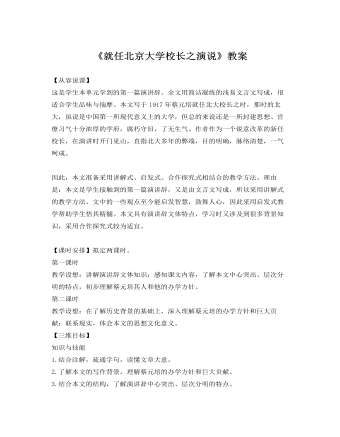
人教版高中语文《就任北京大学校长之演说》教案
蔡元培的道德风范和人格力量,具有震撼人心的作用,深为世人所钦仰。“人世楷模”“善良的社会和庄严的人生的模范”(国立音乐专科学校师生1936年1月《祝蔡孑民先生千秋诗》)的赞誉,对他来说绝非溢美之词。任鸿隽称他具有“处处为人无我的真精神”;“对人接物,似乎有两个原则,一个是尊重他人的人格,决不愿意以自己的语言和行动使人感到一点不快或不便,一个是承认他人的理性,以为天下事无不可以和平自由的方法互相了解或处理。”“但在公义一方面,蔡先生却是特立不屈、勇往直前、丝毫不退、毫不假借的斗士。”(重庆《中央日报》1940年3月24日)他的学生冯友兰也回忆说,在蔡先生身边,感同光风霁月,他的人格能造成一种气象。沐浴在这种气象之中,就不能不为他的人格所感化。蔡元培身居高位,一生廉洁,自奉俭朴,直至晚年仍是全家租赁房屋居住,他酷爱的书籍也分散在北平、上海、南京、杭州等地,没有一个归拢庋藏的地方。蔡元培这种真诚待人、无私奉献、光明磊落的精神,源于他对国家、对民族、对事业、对学生深深的眷恋和崇高的责任感。他的这种浩然正气和高尚道德情操,至今仍是公务人员的楷模。
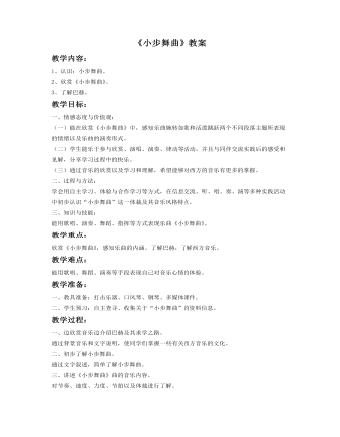
《小步舞曲教案》教案
教学过程:一、边欣赏音乐边介绍巴赫及其求学之路。通过背景音乐和文字说明,使同学们掌握一些有关西方音乐的文化。二、初步了解小步舞曲。通过文字叙述,简单了解小步舞曲。三、讲述《小步舞曲》曲的音乐内容。对节奏、速度、力度、节拍以及体裁进行了解。四、结合谱例分段学习《小步舞曲》。1、学习乐曲A’段。说明:依据乐曲创作背景,合理创设“舞会”情景,从而有效激发学生学习兴趣,用舞蹈表现手段演绎此乐段,发展了学生的舞蹈表演能力,享受到美的愉悦。2、学习乐曲B段。说明:利用形象、直观的图式辅助以及一系列贴近学生思维逻辑的问答讨论,激发学生的思考,帮助学生准确把握乐段情绪,并能用指挥、伴奏等方式表现该乐段。3、完整欣赏《小步舞曲》。说明:学生在完整欣赏乐曲时能够巩固乐曲主题的记忆,并且听辨、感受乐曲两个不同主题情绪,培养学生独立的音乐感受和见解。五、视频欣赏。说明:通过视屏欣赏,使同学们以一个更直观的郊区去理解和学习作品,并使同学对作品有更深刻的记忆。引起学生共鸣,领悟音乐的美感,愉悦身心,获取乐趣,从而激起学习的情趣。
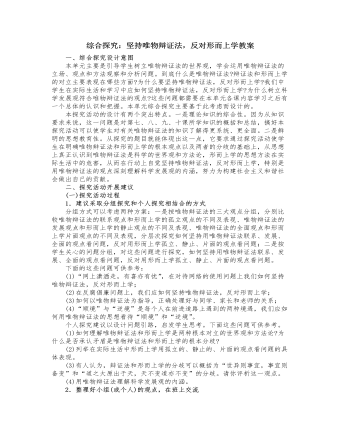
人教版高中政治必修4综合探究:坚持唯物辩证法,反对形而上学教案
5.循环经济当前,发展循环经济和知识经济已成为国际社会的两大趋势,有的发达国家甚至以立法的方式加以推进。循环经济本质上是一种生态经济,它要求运用生态学规律而不是机械的规律来指导人类社会的经济活动,减量化、再利用和资源化是其三大原则。传统经济是一种“资源——产品——污染排放”单向流动的线性经济,特征是高开采、低利用、高排放;与之不同,循环经济倡导的是一种与环境和谐的经济发展模式,它要求把经济活动组织成一个“资源——产品——再生资源”的反馈式流程,特征是低开采、高利用、低排放。目前,我国已经把发展循环经济作为编制“十一五”规划的重要指导原则。6.当心被优势“绊倒”有三个旅行者同时住进一家旅店,早上同时出门旅游。晚上归来时,拿伞的人淋得浑身是水,拿拐杖的人跌得满身是伤,而什么也没有带的人却安然无恙。

中班主题课件教案:“我的朋友”的主题反思
主题目标: 能关注周围环境中的事物,初步了解并体验人与人、人与整个环境和谐相处的快乐感觉;能在成人帮助下逐步形成与他人共处的良好态度;学习并尝试与人交往的方式,促进社会交往能力的发展。 主题的开展: 本月以“我的朋友”为主题,围绕“朋友都有谁、快快乐乐来玩耍、友好相处是朋友、”三个方面的内容展开活动,环境方面突出的是我们有效的利用家长资源,带动幼儿及教师家长的兴趣。 俗话说:“有朋自远方来”孩子年龄随小,但他们也在逐渐与社会接轨,心中都有自己的好朋友,比如有的幼儿说“我爸爸是我的好朋友”“我班xxx 是我的好朋友” “xx班的xxx是我的好朋友”,为此我们组织幼儿完成好朋友画像的活动。目的是通过幼儿讲述,不仅提高幼儿口语表达能力。而且进一步增进好朋友之间的情感。
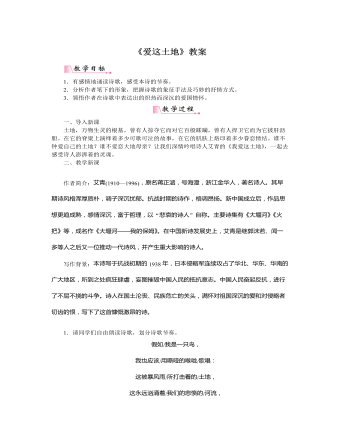
部编版语文九年级上册《我爱这土地》教案
目标导学四:赏析作品,把握诗歌艺术特色1.这首诗在结构上共分两节,请简要说说两节诗歌各有什么特点及它们之间的内在联系。明确:诗的第一节是从虚拟的视角,即从鸟儿的视角去想象,去表现鸟儿对土地的忠诚与挚爱,显得形象含蓄;第二节却换成实写的视角,即从作者自我的视角去实写自己“常含泪水的眼睛”,倾诉自己对土地的“深沉”之爱,是直抒胸臆。这样,虚境和实境的结合与对应,构筑了全诗内在完整的艺术空间;结果与原因的关联与对照,又构成了支撑全诗的内在逻辑结构。此外,从手法特点上看,第一节用的是比,是想象的境界;第二节则是直抒胸臆的写实。全诗由前面蒙太奇镜头式的画面暗示转到了后面作者的直接指点,以一个强有力的情感抒发结束了全篇,从而把注意力引到一个浓郁的情感氛围中,再一次感受到作者对土地的忠贞与挚爱。
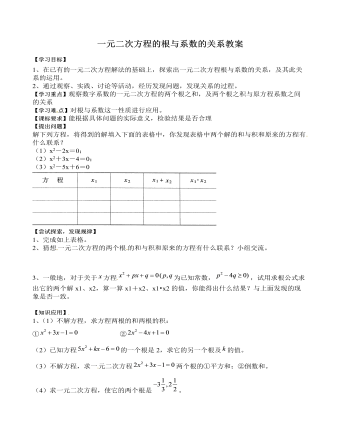
北师大初中数学九年级上册一元二次方程的根与系数的关系2教案
3、一般地,对于关于 方程 为已知常数, ,试用求根公式求出它的两个解x1、x2,算一算x1+x2、x1?x2的值,你能得出什么结果?与上面发现的现象是否一致。【知识应用】 1、(1)不解方程,求方程两根的和两根的积:① ② (2)已知方程 的一个根是2,求它的另一个根及 的值。(3)不解方程,求一 元二次方程 两个根的①平方和;②倒数和。(4)求一元二次方程,使它的两个根是 。【归纳小结】【作业】1、已知方程 的一个根是1,求它的另一个根及 的值。2、设 是方程 的两个根,不解方程,求下列各式的值。① ;② 3、求一个一元次方程,使它的两 个根分别为:① ;② 4、下列方程两根的和与两根的积各是多少 ?① ; ② ; ③ ; ④ ;
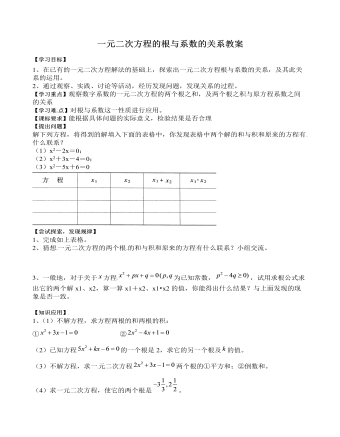
北师大初中数学九年级上册一元二次方程的根与系数的关系2教案
2、猜想 一元二次方程的两个根 的和与积和原来的方程有什么联系?小组交流。3、一般地,对于关于 方程 为已知常数, ,试用求根公式求出它的两个解x1、x2,算一算x1+x2、x1?x2的值,你能得出什么结果?与上面发现的现象是否一致。【知识应用】 1、(1)不解方程,求方程两根的和两根的积:① ② (2)已知方程 的一个根是2,求它的另一个根及 的值。(3)不解方程,求一 元二次方程 两个根的①平方和;②倒数和。(4)求一元二次方程,使它的两个根是 。【归纳小结】【作业】1、已知方程 的一个根是1,求它的另一个根及 的值。2、设 是方程 的两个根,不解方程,求下列各式的值。① ;② 3、求一个一元次方程,使它的两 个根分别为:① ;② 4、下列方程两根的和与两根的积各是多少 ?① ; ② ; ③ ; ④ ;
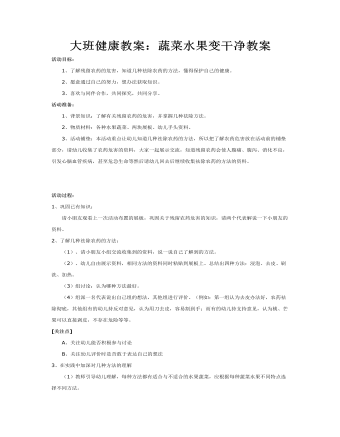
大班健康教案:蔬菜水果变干净教案
活动准备:1、背景知识:了解有关残留农药的危害,并掌握几种祛除方法。2、物质材料:各种水果蔬菜、两块展板、幼儿手头资料。3、活动铺垫:本活动重点让幼儿知道几种祛除农药的方法,所以把了解农药危害放在活动前的铺垫部分,请幼儿收集了农药危害的资料,大家一起展示交流,知道残留农药会使人腹痛、腹泻、消化不良,引发心脑血管疾病,甚至危急生命等然后请幼儿回去后继续收集祛除农药的方法的资料。
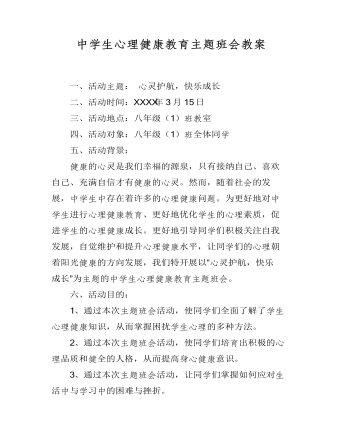
中学生心理健康教育主题班会教案
五、活动背景:健康的心灵是我们幸福的源泉,只有接纳自己、喜欢自己、充满自信才有健康的心灵。然而,随着社会的发展,中学生中存在着许多的心理健康问题。为更好地对中学生进行心理健康教育、更好地优化学生的心理素质,促进学生的心理健康成长。更好地引导同学们积极关注自我发展,自觉维护和提升心理健康水平,让同学们的心理朝着阳光健康的方向发展,我们特开展以“心灵护航,快乐成长”为主题的中学生心理健康教育主题班会

中班传统文化社会教案幼儿园传统文化教案
1、对春联产生兴趣,乐于交流自己的发现。 2、大胆探索并发现春联的特征和种类,体验张贴春联的的乐趣。 3、初步了解春联的演变。 【活动准备】 物质准备: 1、春节里幼儿与家长一起贴春联的照片。 2、红纸、毛笔、砚台等。 经验准备: 1、幼儿有贴春联的经验 2、了解春联的由来和传说。 3、联系会写春联的家长助教
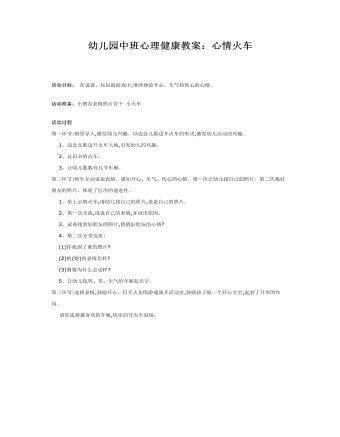
幼儿园中班心理健康教案:心情火车
活动准备:小朋友表情照片若干小火车 活动过程第一环节:情景导入,激发幼儿兴趣。以边念儿歌边开火车的形式,激发幼儿活动的兴趣。 1、边念儿歌边开火车入场,引发幼儿的兴趣。 2、认识心情火车。 3、让幼儿数数有几节车厢。 第二环节:师生互动说说表情。感知开心、生气、伤心的心情。第一次让幼儿找自己的照片。第二次找好朋友的照片。体现了层次的递进性。 1、坐上心情火车,请幼儿找自己的照片,说说自己的照片。 2、第一次交流,说说自己的表情,并说出原因。
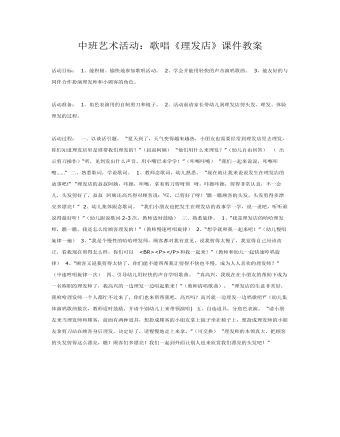
中班艺术活动:歌唱《理发店》课件教案
活动准备: 1、角色表演用的自制剪刀和镜子。 2、活动前请家长带幼儿到理发店剪头发、理发、体验理发的过程。活动过程: 一、以谈话引题。 “夏天到了,天气变得越来越热,小朋友也需要经常到理发店里去理发,你们知道理发店里是谁帮我们理发的?”(叔叔阿姨) “他们用什么来理发?”(幼儿自由回答) (出示剪刀操作)“听,见到发出什么声音,用小嘴巴来学学!”(咔嚓咔嚓) “我们一起来说说,咔嚓咔嚓……” 二、熟悉歌词,学说歌词。 1、教师念歌词,幼儿熟悉。 “现在就让我来说说发生在理发店的故事吧!” “理发店的叔叔阿姨,咔擦,咔嚓,拿着剪刀剪呀剪 呀,咔擦咔擦,剪得非常认真,不一会儿,头发剪好了,叔叔 阿姨还高兴得对顾客说:‘哎,已剪好了呀!’瞧一瞧顾客的头发,头发剪得多漂亮多漂亮!”
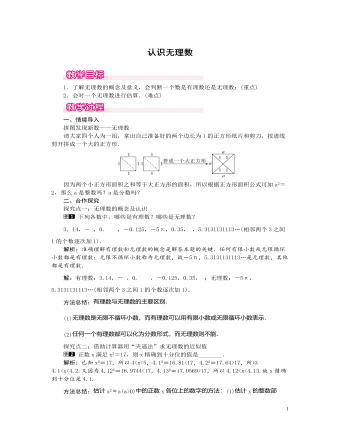
北师大初中数学八年级上册认识无理数1教案
解:有理数:3.14,-53,0.58··,-0.125,0.35,227;无理数:-5π,5.3131131113…(相邻两个3之间1的个数逐次加1).方法总结:有理数与无理数的主要区别.(1)无理数是无限不循环小数,而有理数可以用有限小数或无限循环小数表示.(2)任何一个有理数都可以化为分数形式,而无理数则不能.探究点二:借助计算器用“夹逼法”求无理数的近似值正数x满足x2=17,则x精确到十分位的值是________.解析:已知x2=17,所以417,所以4.117,所以4.120)中的正数x各位上的数字的方法:(1)估计x的整数部分,看它在哪两个连续整数之间,较小数即为整数部分;(2)确定x的十分位上的数,同样寻找它在哪两个连续整数之间;(3)按照上述方法可以依次确定x的百分位、千分位、…上的数,从而确定x的值.